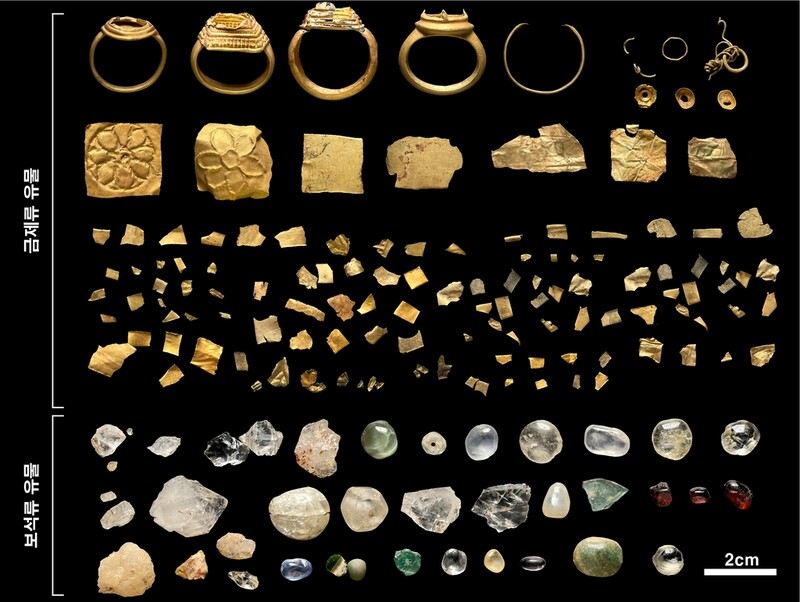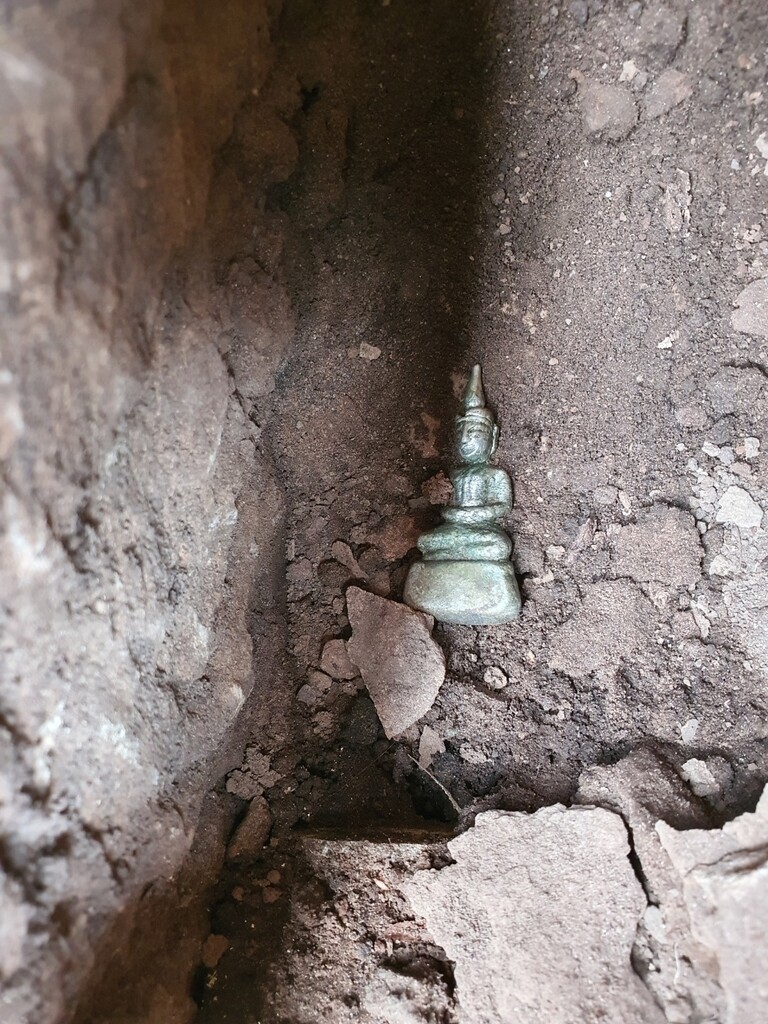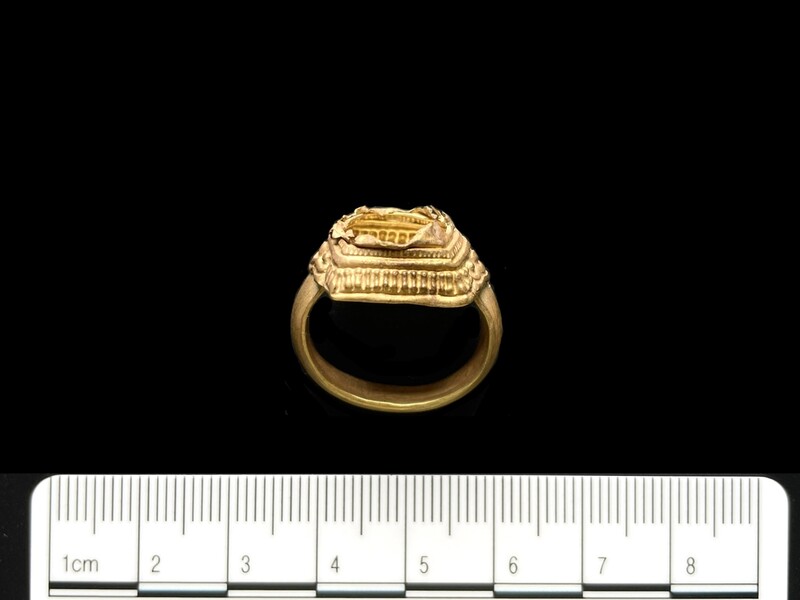 |
| ▲ This photo, provided by the Korea Cultural Heritage Foundation, shows the relics excavated from the Hong Nang Sida Temple in Laos. (PHOTO NOT FOR SALE) (Yonhap) |
 |
| ▲ This photo, provided by the Korea Cultural Heritage Foundation, shows the place of the Hong Nang Sida Temple, where the cellar is visible on the left side. A large room in the middle, and a small room to the east, west, south and north is also seen. (PHOTO NOT FOR SALE) (Yonhap) |
 |
| ▲ This photo, provided by the Korea Cultural Heritage Foundation, shows the investigation scene of the Hong Nang Sida Temple. (PHOTO NOT FOR SALE) (Yonhap) |
 |
| ▲ This photo, provided by the Korea Cultural Heritage Foundation, shows the Buddhist statue excavated from the yard of the Hong Nang Sida Temple in Laos. (PHOTO NOT FOR SALE) (Yonhap) |
 |
| ▲ This photo, provided by the Korea Cultural Heritage Foundation, shows the gold ring excavated from the yard of the Hong Nang Sida Temple in Laos. (PHOTO NOT FOR SALE) (Yonhap) |
SEOUL, June 30 (Yonhap) -- A Korean cultural heritage investigation team discovered 237 gold relics and 317 relics, including crystals of various colors, at the Hong Nang Sida Temple in Laos.
It is evaluated as a meaningful archaeological achievement as it is rare for such a large number of gold relics to be found in the region of the Khmer Kingdom, which had been influential in Southeast Asia. Also, an unusually unearthed silver Buddhist statue from a Hindu temple is expected to draw attention from the academic world.
The Cultural Heritage Administration and the Korea Cultural Heritage Foundation announced on June 30 that they recovered 317 artifacts during an investigation of the dismantling of the collapsed sanctuary "cellar," which is a part of the "Associated Ancient Settlements within the Champasak Cultural Landscape."
Hong Nang Sida Temple in southern Laos is a Khmer ruin that means "Princess Sida's big building." The Korean government has been promoting conservation and restoration projects of this place since 2013, and in 2019, the gilt-bronze statue of the female genitalia, "Yoni," was discovered in Laos for the first time.
Cellar's internal investigation was conducted from last year to last May. The cellar is structured with a large room in the center and small rooms in the east, west, south, and north directions. When viewed from the sky, it is shaped like a cross.
A hole with a depth of at least 4.5 m was identified in the central cellar room. This "central pit" was a facility symmetrical with the spire, and important deities were also enshrined there. The team conveyed that it is the first time for a central pit to be discovered in Laos.
"There are similar central pits in Cambodia's Angkor and in the Bayon temple," Jeon Yu-geun, deputy head of the Korea Cultural Heritage Foundation said. "While different scholars look at the construction period of Hong Nang Sida Temple differently, considering the structure of the central pits and the contents of the inscriptions confirmed in the past, it is judged to be built in the 12th century.”
Most of the artifacts were excavated from the central chamber. The gold relics consist of 5 gold rings, 217 gold leaf plates, and 15 gold decorations. The gold ring has a circumference of about 2.5 cm, and some decorations are made with a thickness of 0.2 mm. The thickness of the gold lead plate is 0.2 to 0.3 mm. Some of the gold decorations were engraved with floral patterns, and there are also relics believed to be accessories for necklaces and earrings.
Gold rings consist of 70-80% gold, 15-25% silver, and 3-7% copper, while old leaf plates are divided into 70-85% gold and 50-60% gold.
In addition to the forbidden artifacts, white, green, red, and yellow crystals were found.
“If you look at the gold relics, it looks like they were made with different alloy ratios depending on the nature of the substance,” said deputy manager Jeon. "The gold leaf plate seems to have been enshrined in the temple in a religious sense.”
He said, "As geologically, gold and crystals cannot be produced in the area around Hong Nang Sida Temple, there is a high chance that it was manufactured in another area and then was brought here."
The investigation team also paid attention to the silver Buddha statue recovered along with Yoni. This statue is believed to have been built in the 17th century.
"The Buddhist statue was placed in a place where people from the future generation could not place it," said deputy manager Jeon. "Laos adopted Buddhism as the state religion on the 14th century. It is thought that Hong Nang Sida Temple remained in operation until the 17th century, when the Buddha statue was made, without being collapsed."
"In order to find out when the temple collapsed, we will conduct an art history survey of the silver Buddha statue and carry out radiocarbon dating as well."
"The shiny relics of Hong Nang Sida Temple are a source of information about Laos' metal working techniques and trade patterns," said Mrs Suanesavanh Vignaket, the Ministry of Information, Culture and Tourism of Laos.
The Korea Cultural Heritage Foundation previously restored the "Mandapa" and the platform, a rectangular space for worship and ceremonies at the Hong Nang Sida Temple. In the second half of the year, they also plan to investigate the exterior of the cellar.
(This article is translated from Korean to English by Haemin Kim.)
(END)
(C) Yonhap News Agency. All Rights Reserved


















![[방송소식] 낭비 습관 고치는 예능 '짠남자'에 김종국·장도연](https://korean-vibe.com/news/data/20240423/yna1065624915371291_419.jpg)




